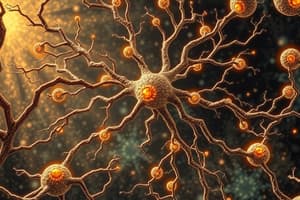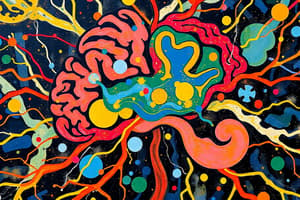Podcast
Questions and Answers
What did the neuron doctrine replace in the study of the nervous system?
What did the neuron doctrine replace in the study of the nervous system?
- Synaptic theory
- Reticular theory (correct)
- Cytoplasmic theory
- Microscopic theory
Which individual developed a tissue staining technique that enhanced the observation of nerve cells?
Which individual developed a tissue staining technique that enhanced the observation of nerve cells?
- Camillo Golgi (correct)
- Igor Tamm
- Santiago Ramón y Cajal
- Ramon Arevalo
In what year did Golgi and Cajal win the Nobel Prize in Physiology or Medicine?
In what year did Golgi and Cajal win the Nobel Prize in Physiology or Medicine?
- 1908
- 1910
- 1904
- 1906 (correct)
Despite the evidence supporting the neuron doctrine, what theory did Golgi maintain belief in?
Despite the evidence supporting the neuron doctrine, what theory did Golgi maintain belief in?
What artistic method did Cajal use to illustrate his findings on the brain and nervous system?
What artistic method did Cajal use to illustrate his findings on the brain and nervous system?
What significant theory did Cajal discredit in 1888 regarding nerve cells?
What significant theory did Cajal discredit in 1888 regarding nerve cells?
What technique did Cajal modify in 1888 to enhance his research on the nervous system?
What technique did Cajal modify in 1888 to enhance his research on the nervous system?
What was the outcome of Cajal's joint Nobel Prize award in 1906?
What was the outcome of Cajal's joint Nobel Prize award in 1906?
What were Cajal's initial studies focused on before he shifted to histology?
What were Cajal's initial studies focused on before he shifted to histology?
What advantage did advancements in optical lenses provide to Cajal's research in the 1870s?
What advantage did advancements in optical lenses provide to Cajal's research in the 1870s?
Which characteristic of Cajal's upbringing influenced his career in neuroscience?
Which characteristic of Cajal's upbringing influenced his career in neuroscience?
What visual representation was a vital part of Cajal's publications?
What visual representation was a vital part of Cajal's publications?
Which aspect of Cajal's life contributed to his effectiveness as a neuroscientist?
Which aspect of Cajal's life contributed to his effectiveness as a neuroscientist?
What was a significant outcome of Cajal's modification of Golgi's staining technique?
What was a significant outcome of Cajal's modification of Golgi's staining technique?
What fundamental concept did Cajal's observations support regarding nerve cells?
What fundamental concept did Cajal's observations support regarding nerve cells?
What was one of Cajal's key achievements in his research method?
What was one of Cajal's key achievements in his research method?
Which of the following is NOT true about Cajal's hand-drawn illustrations?
Which of the following is NOT true about Cajal's hand-drawn illustrations?
What significant aspect of neuron communication did Cajal discover?
What significant aspect of neuron communication did Cajal discover?
How did Cajal's work impact the perception of the nervous system's structure?
How did Cajal's work impact the perception of the nervous system's structure?
What was one of the reasons Cajal's legacy is preserved at Spain's Cajal Institute?
What was one of the reasons Cajal's legacy is preserved at Spain's Cajal Institute?
Which theory was primarily challenged by Cajal's Neuron Doctrine?
Which theory was primarily challenged by Cajal's Neuron Doctrine?
Flashcards are hidden until you start studying
Study Notes
Santiago Ramón y Cajal
- Spanish neuroscientist and artist who revolutionized our understanding of the nervous system.
- Pioneer in the use of microscopes for neuroanatomy.
- Born in northern Spain and became a physician.
- Passionate about drawing, which enhanced his scientific observations.
Cajal's Discoveries
- Disproved the reticular theory, which stated that nerve cells are connected in a continuous web.
- Proposed the neuron doctrine, which states that the nervous system is composed of individual, independent neurons that communicate with each other.
- Modified Golgi's staining method, allowing for clearer visualization of nerve cells.
Key Techniques and Contributions
- Golgi’s technique for staining nerve cells black with silver nitrate was a major breakthrough.
- Cajal improved the technique, allowing for greater detail in visualizing nerve cell structures.
- Extensive use of microscopy and staining techniques to meticulously observe and analyze the structure of nerve cells.
- Prolific writer and artist, publishing over 100 articles and producing over 2,900 detailed drawings of the brain and nervous system.
The Neuron Doctrine
- Defined the fundamental unit of the nervous system as the neuron.
- Established the concept of synaptic transmission, where signals are passed between neurons across tiny gaps.
- Revolutionized the understanding of how the nervous system is organized and functions.
Cajal's Legacy
- Joint Nobel Prize winner (1906) in Physiology or Medicine with Camillo Golgi for their contributions to neuroscience.
- His work continues to be studied and cited by scientists worldwide.
- The Cajal Institute in Spain houses his extensive collection of scientific drawings and archives.
Studying That Suits You
Use AI to generate personalized quizzes and flashcards to suit your learning preferences.





